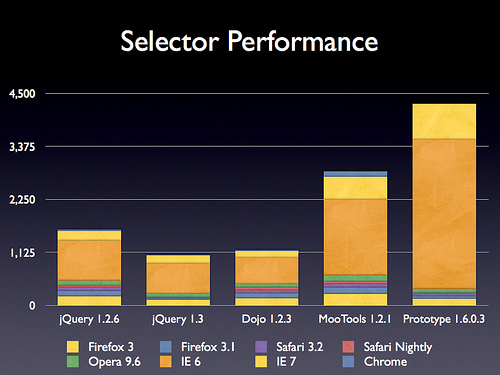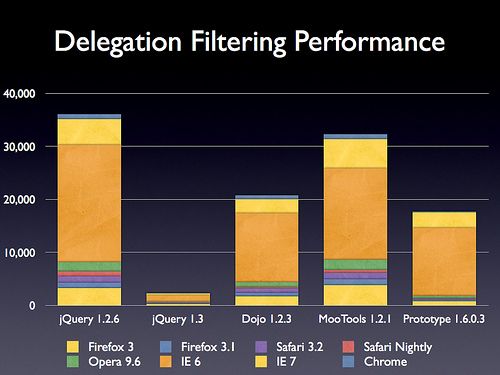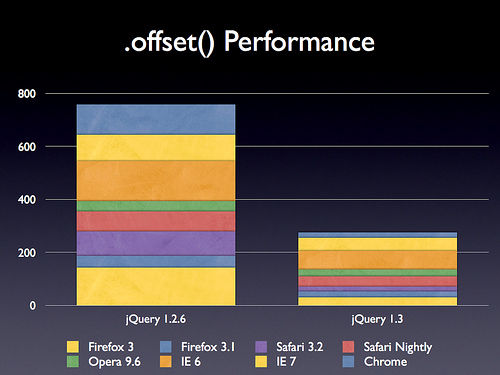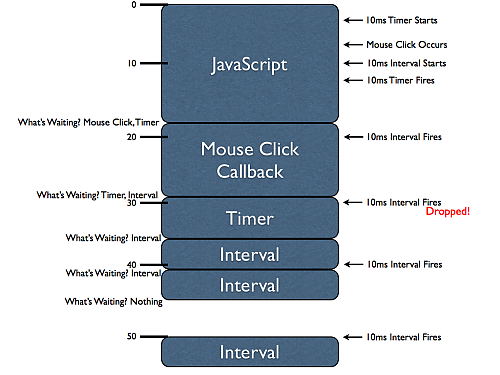浏览模式: 标准 | 列表分类:Javascript
Submitted by gouki on 2009, January 15, 4:13 PM
Something from jQuery's Blog :
Happy Birthday to jQuery! jQuery is three years old today, after being released way back on January 14th, 2006 at the first BarCampNYC by John Resig.
We have four announcements for you today, we hope you’ll enjoy them!
Url:http://blog.jquery.com/2009/01/14/jquery-13-and-the-jquery-foundation/
中文翻译:http://shawphy.com/2009/01/release-jquery-1-3.html
jQuery 1.3终于发布了。
min版(gzip后18kb)
源码(114kb)
另外可以用google的代码托管:
http://ajax.googleapis.com/ajax/libs/jquery/1.3/jquery.min.js
下面这个是我自己用Packer压缩的pack版
http://shawphy.com/down/jquery-1.3.pack.js(37kb)
简要来说:
更新了Sizzle选择器引擎,这个之前也提到过。可以查看他的性能:

此外据声称,把代码给了dojo基金会。这回Sizzle的野心在于能够让其他各种JS库都能用,包括Prototype, Dojo, Yahoo UI, MochiKit, 和 TinyMCE等等其他库。
live 事件
这也是jQuery 1.3这次更新的第二个重大更新。(注:这里有一个iframe,我没有复制过来,请到原站观赏和测试)
性能比较:

这样,我以前写的关于重复绑定的文章就差不多可以抛弃了
Event 对象
新增了一个jQuery.Event对象,他根据w3c文档,做了一个完整的,兼容所有浏览器的一个对象。具体还得看文档。
append, prepend, before, 和 after 方法重写
据声称,这些方法的效率提升了6倍

重写了offset方法
这回更快了

取消了浏览器侦测,全面改用jQuery.support
具体还得看文档了。
变化:
其中与开发者比较密切的是
[@attr] 中的@在1.3里不能用了
用trigger触发的事件现在能冒泡了
ready方法中,再也不等css加载完了再执行其中代码了。直接要求把css放在脚本之前就行
简化了.isFunction方法,那些偏门的就被无视了
用选择器a, b, c选择东西,在支持querySelectorAll (Safari, Firefox 3.1+, Opera 10+, IE 8+)中会按照这些元素在文档中顺序来确定这些数组在获得的对象列表中的位置。而不支持这个方法的浏览器则按照选择器顺序排好
新增了jQuery.Event
要求网页都在标准模式下,不要在怪异模式下使用,否则会报错。
以下3个方法属性已被不推荐使用。
* jQuery.browser
* jQuery.browser.version
* jQuery.boxModel
具体内容:
内核部分:
更好的queue, dequeue
新增selector, context这两个属性,分别指向获取这个元素的原始选择器和被查找的内容(可选)
选择器部分:
Sizzle的使用
复杂的css例如not(a, b)
属性部分:
toggleClass( “className”, state ) - 增加了一个布朗值的参数。
筛选文档:
.closest( selector ) - 找到离这个元素最近的一个父元素。这跟parents不一样。
is() 也支持更复杂的选择器了。
操作文档:
HTML Injection重写了
$(”<script/>”) 就自动转化为 $(document.createElement(”script”))
css:
offset()重写了
事件:
Live 事件
jQuery.Event
trigger()会冒泡了
效果:
hide() .show()之类的加快速度
内置动画效果考虑到了margin和 padding
.toggle( boolean ) 多提供了一个参数
jQuery.fx.off 关闭所有动画
AJAX:
.load()支持了文本格式的数据
工具:
新增jQuery.isArray
内部:
jQuery.support
另外这回改用YUI的工具压脚本了
========================================
最后预告一下,jQuery文档官网已经针对1.3版做了修改,中文文档也在紧张制作中。
Tags: jquery, 1.3, 三周年
Javascript | 评论:0
| 阅读:20884
Submitted by gouki on 2009, January 14, 11:25 AM
根据官方的博客,说是1月14日前发布release前最后一个版本了。不知道什么时候有的下载和测试,不过仍然是不建议用在项目中,还是等稳定版吧。
那个常见的@终于要消失了。新的引擎效率应该快上很多吧。
关注官方:www.jquery.com
Tags: jquery, beta, release
Javascript | 评论:0
| 阅读:17440
Submitted by gouki on 2008, December 29, 10:59 AM
转载这篇文章的原因是它解释了setTimeout和setInterval之间的区别,对于这篇文章,博客园有位朋友进行了翻译,网址如下:http://www.cnblogs.com/rainman/archive/2008/12/26/1363321.html
翻译内容为:
How JavaScript Timers Work
从基础的层面来讲,理解JavaScript的定时器是如何工作的是非常重要的。计时器的执行常常和我们的直观想象不同,那是因为JavaScript引擎是单线程的。我们先来认识一下下面三个函数是如何控制计时器的。
var id = setTimeout(fn, delay); - 初始化一个计时器,然后在指定的时间间隔后执行。该函数返回一个唯一的标志ID(Number类型),我们可以使用它来取消计时器。var id = setInterval(fn, delay); - 和setTimeout有些类似,但它是连续调用一个函数(时间间隔是delay参数)直到它被取消。clearInterval(id);, clearTimeout(id); - 使用计时器ID(setTimeout 和 setInterval的返回值)来取消计时器回调的发生
为了理解计时器的内在执行原理,有一个重要的概念需要加以探讨:计时器的延迟(delay)是无法得到保障的。由于所有JavaScript代码是在一个线程里执行的,所有异步事件(例如,鼠标点击和计时器)只有拥有执行机会时才会执行。用一个很好的图表加以说明:

(点击查看大图)
在这个图表中有许多信息需要理解,如果完全理解了它们,你会对JavaScript引擎如何实现异步事件有一个很好的认识。这是一个一维的图标:垂 直方向表示时间,蓝色的区块表示JavaScript代码执行块。例如第一个JavaScript代码执行块需要大约18ms,鼠标点击所触发的代码执行 块需要11ms,等等。
由于JavaScript引擎同一时间只执行一条代码(这是由于JavaScript单线程的性质),所以每一个JavaScript代码执行块会 “阻塞”其它异步事件的执行。这就意味着当一个异步事件发生(例如,鼠标点击,计时器被触发,或者Ajax异步请求)后,这些事件的回调函数将排在执行队 列的最后等待执行(实际上,排队的方式根据浏览器的不同而不同,所以这里只是一个简化);
从第一个JavaScript执行块开始研究,在第一个执行块中两个计时器被初始化:一个10ms的setTimeout()和一个10ms的setInterval()。 依据何时何地计时器被初始化(计时器初始化完毕后就会开始计时),计时器实际上会在第一个代码块执行完毕前被触发。但是,计时器上绑定的函数不会立即执行 (不被立即执行的原因是JavaScript是单线程的)。实际上,被延迟的函数将依次排在执行队列的最后,等待下一次恰当的时间再执行。
此外,在第一个JavaScript执行块中我们看到了一个“鼠标点击”事件发生了。一个JavaScript回调函数绑定在这个异步事件上了(我 们从来不知道用户什么时候执行这个(点击)事件,因此认为它是异步的),这个函数不会被立即执行,和上面的计时器一样,它将排在执行队列的最后,等待下一 次恰当的时候执行。
当第一个JavaScript执行块执行完毕后,浏览器会立即问一个问题:哪个函数(语句)在等待被执行?在这时,一个“鼠标点击事件处理函数”和 一个“计时器回调函数”都在等待执行。浏览器会选择一个(实际上选择了“鼠标点击事件的处理函数”,因为由图可知它是先进队的)立即执行。而“计时器回调 函数”将等待下次适合的时间执行。
注意,当“鼠标点击事件处理函数”执行的时候,setInterval的回调函数第一次被触发了。和setTimeout的回调函数一样,它将排到执行队列的最后等待执行。但是,一定要注意这一点:当setInterval回调函数第二次被触发时(此时setTimeout函数仍在执行)setTimeout的第一次触发将被抛弃掉。当一个很长的代码块在执行时,可能把所有的setInterval回调函数都排在执行队列的后面,代码块执行完之后,结果便会是一大串的setInterval回调函数等待执行,并且这些函数之间没有间隔,直到全部完成。所以,浏览器倾向于的当没有更多interval的处理函数在排队时再将下一个处理函数排到队尾(这是由于间隔的问题)。
我们能够发现,当第三个setInterval回调函数被触发时,之前的setInterval回调函数仍在执行。这就说明了一个很重要的事实:setInterval不会考虑当前正在执行什么,而把所有的堵塞的函数排到队列尾部。这意味着两次setInterval回调函数之间的时间间隔会被牺牲掉(缩减)。
最后,当第二个setInterval回调函数执行完毕后,我们可以看到没有任何程序等待JavaScript引擎执行了。这就意味着浏览器现在在等待一个新的异步事件的发生。在50ms时一个新的setInterval回调函数再次被触发,这时,没有任何的执行块阻塞它的执行了。所以它会立刻被执行。
让我们用一个例子来阐明setTimeout和setInterval之间的区别:
setTimeout(function(){
/* Some long block of code... */
setTimeout(arguments.callee, 10);
}, 10);
setInterval(function(){
/* Some long block of code... */
}, 10);
这两句代码乍一看没什么差别,但是它们是不同的。setTimeout回调函数的执行和上一次执行之间的间隔至少有10ms(可能会更多,但不会少于10ms),而setInterval的回调函数将尝试每隔10ms执行一次,不论上次是否执行完毕。
在这里我们学到了很多知识,总结一下:
- JavaScript引擎是单线程的,强制所有的异步事件排队等待执行
setTimeout 和 setInterval 在执行异步代码的时候有着根本的不同- 如果一个计时器被阻塞而不能立即执行,它将延迟执行直到下一次可能执行的时间点才被执行(比期望的时间间隔要长些)
- 如果
setInterval回调函数的执行时间将足够长(比指定的时间间隔长),它们将连续执行并且彼此之间没有时间间隔。
上述这些知识点都是非常重要的。了解了JavaScript引擎是如何工作的,尤其是大量的异步事件(连续)发生时,才能为构建高级应用程序打好基础。
英文原文如下:
At a fundamental level it's important to understand how JavaScript timers work. Often times they behave unintuitively because of the single thread which they are in. Let's start by examining the three functions to which we have access that can construct and manipulate timers.
var id = setTimeout(fn, delay); - Initiates a single timer which will call the specified function after the delay. The function returns a unique ID with which the timer can be canceled at a later time.var id = setInterval(fn, delay); - Similar to setTimeout but continually calls the function (with a delay every time) until it is canceled.clearInterval(id);, clearTimeout(id); - Accepts a timer ID (returned by either of the aforementioned functions) and stops the timer callback from occurring.
In order to understand how the timers work internally there's one important concept that needs to be explored: timer delay is not guaranteed. Since all JavaScript in a browser executes on a single thread asynchronous events (such as mouse clicks and timers) are only run when there's been an opening in the execution. This is best demonstrated with a diagram, like in the following:

There's a lot of information in this figure to digest but understanding it completely will give you a better realization of how asynchronous JavaScript execution works. This diagram is one dimensional: vertically we have the (wall clock) time, in milliseconds. The blue boxes represent portions of JavaScript being executed. For example the first block of JavaScript executes for approximately 18ms, the mouse click block for approximately 11ms, and so on.
Since JavaScript can only ever execute one piece of code at a time (due to its single-threaded nature) each of these blocks of code are "blocking" the progress of other asynchronous events. This means that when an asynchronous event occurs (like a mouse click, a timer firing, or an XMLHttpRequest completing) it gets queued up to be executed later (how this queueing actually occurs surely varies from browser-to-browser, so consider this to be a simplification).
To start with, within the first block of JavaScript, two timers are initiated: a 10ms setTimeout and a 10ms setInterval. Due to where and when the timer was started it actually fires before we actually complete the first block of code. Note, however, that it does not execute immediately (it is incapable of doing that, because of the threading). Instead that delayed function is queued in order to be executed at the next available moment.
Additionally, within this first JavaScript block we see a mouse click occur. The JavaScript callbacks associated with this asynchronous event (we never know when a user may perform an action, thus it's consider to be asynchronous) are unable to be executed immediately thus, like the initial timer, it is queued to be executed later.
After the initial block of JavaScript finishes executing the browser immediately asks the question: What is waiting to be executed? In this case both a mouse click handler and a timer callback are waiting. The browser then picks one (the mouse click callback) and executes it immediately. The timer will wait until the next possible time, in order to execute.
Note that while mouse click handler is executing the first interval callback executes. As with the timer its handler is queued for later execution. However, note that when the interval is fired again (when the timer handler is executing) this time that handler execution is dropped. If you were to queue up all interval callbacks when a large block of code is executing the result would be a bunch of intervals executing with no delay between them, upon completion. Instead browsers tend to simply wait until no more interval handlers are queued (for the interval in question) before queuing more.
We can, in fact, see that this is the case when a third interval callback fires while the interval, itself, is executing. This shows us an important fact: Intervals don't care about what is currently executing, they will queue indiscriminately, even if it means that the time between callbacks will be sacrificed.
Finally, after the second interval callback is finished executing, we can see that there's nothing left for the JavaScript engine to execute. This means that the browser now waits for a new asynchronous event to occur. We get this at the 50ms mark when the interval fires again. This time, however, there is nothing blocking its execution, so it fires immediately.
Let's take a look at an example to better illustrate the differences between setTimeout and setInterval.
setTimeout(function(){
/* Some long block of code... */
setTimeout(arguments.callee, 10);
}, 10);
setInterval(function(){
/* Some long block of code... */
}, 10);
These two pieces of code may appear to be functionally equivalent, at first glance, but they are not. Notably the setTimeout code will always have at least a 10ms delay after the previous callback execution (it may end up being more, but never less) whereas the setInterval will attempt to execute a callback every 10ms regardless of when the last callback was executed.
There's a lot that we've learned here, let's recap:
- JavaScript engines only have a single thread, forcing asynchronous events to queue waiting for execution.
setTimeout and setInterval are fundamentally different in how they execute asynchronous code.- If a timer is blocked from immediately executing it will be delayed until the next possible point of execution (which will be longer than the desired delay).
- Intervals may execute back-to-back with no delay if they take long enough to execute (longer than the specified delay).
All of this is incredibly important knowledge to build off of. Knowing how a JavaScript engine works, especially with the large number of asynchronous events that typically occur, makes for a great foundation when building an advanced piece of application code.
Tags: javascript, settimeout, setinterval
Javascript | 评论:0
| 阅读:22722
Submitted by gouki on 2008, December 24, 11:04 PM
说实话,我看到这个标题的时候没有看懂,确实没有理解本文的标题想表达什么意思。看完之后我是理解了。先贴上原文,再谈我的理解。。。
原文地址:http://www.cn-cuckoo.com/2008/12/24/shallow-or-deep-copy-and-pass-by-value-or-reference-270.html
内容如下:
XML/HTML代码
- 这个标题念起来有点拗口,但却是理解数据结构的关键。标题中的4个术语,对应的英文分别是:shallow copy(注意,不是shadow copy)、deep copy、pass by value、pass by reference(或pass by address)。传址和传引用是一回事。
-
- 一门编程语言的核心是数据结构,粗略来讲,可以把数据结构分成不可变类型(immutable)和可变类型(mutable)。为什么这么分呢?这涉及到内存分配问题。对于不可变类型,只要分配有限的内存空间即可,而对于不可变类型,理论上则要分配没有大小限制的空间。因此,这么分是出于合理利用系统资源的考虑。实际上,堆内存和栈内存分别用于保存不可变类型值和可变类型值。
-
- 什么是不可变类型?就是该值一旦赋予某个变量,就只属于某个变量,不能同属于其他变量。如:
-
- var stringValue = “I’m immutable data structure, mean you can’t modify me!”;
- var anotherStringValue = stringValue;
- stringValue = “I have changed”;
-
- 此时,anotherStringValue中保存的值会不会也变成“I have changed”?不会。因为
-
- var anotherStringValue = stringValue;
-
- 照stringValue中保存的字符串的原样,复制一个字符串(相应地,在内存中分配一块新空间),并将该字符串赋给 anotherStringValue。换句话说,这两个变量虽然保存的值相同,但它们的值并不在一块内存中。因此,修改任何一个变量,都不会影响另一个变量。即
-
- stringValue = “I have changed”;
-
- 只会影响stringValue的值。但是,确切来讲,stringValue = “I have changed”;并不是修改stringValue,而是创建了一个新字符串(相应地,在内存中分配一块新空间),然后让stringValue引用该字符串——更像是替换变量的值;原来的字符串呢?因为没有变量引用它,也就成为垃圾了(当然,垃圾所占用的内存会被回收)。
-
- 由此可见,赋值操作对于不变类型而言,传递的是内存中的值本身。那么,对于可变类型呢?当然,传递的是内存中值的引用(或者说地址),而且无论传递多少次,内存中始终都只有一份原始值——毕竟可变类型大小莫测,只保存一份原始值能最大限度节省内存空间。例如:
-
- var objectValue = {1:1,’s’:’string’,'innerObject’:{’innerArray’ : [1,2,3]}};
- var anotherObjectValue = objectValue;
- objectValue[1] = 100;
- anotherObjectValue[1]; //100
-
- 不言自明,这里的anotherObjectValue通过赋值操作,从objectValue那里只获得了对原始对象( {1:1,’s’:’string’,'innerObject’:{’innerArray’ : [1,2,3]}})的引用,也就是该对象在内存中的地址,或者说“门牌号码”。因此,修改通过objectValue修改原始对象的第一个元素(objectValue[1] = 100;),结果当然会在anotherObjectValue[1]这里得到反映了。
-
- 在JavaScript中,给函数传递参数是按照上述默认约定——即对不可变类型,传值;对可变类型,传址——进行的。如:
-
- function example(str, obj){
- ……
- }
- example(stringValue,objectValue);
-
- 调用example函数时,第一个参数传递的是实际的字符串值,第二参数传递的是对象的引用(内存地址)。
-
- 在PHP中,定义函数时可以指定相应参数是传值还是传址——通常是传值。其实,这也很容易理解:假如函数要求为某个可变类型参数传值,而不是传址,那么也就意味着内存中会因此多出一份该类型值的副本。相应地,在函数中修改这份新副本,不会影响函数外的原副本。因为新旧副本在内存中就不是同一个地址。说到这,也就引出了浅复制和深复制的概念。事实上,浅复制和深复制的区别恰恰在于复制可变类型时,是传值还是传址。如果是像往常一样传址(传引用),那么就是浅复制。如果是传值,那么就是深复制。浅复制和深复制到底有什么区别呢?以下面的Python代码为例:
-
- >>> x = {’username’: ‘admin’, ‘machines’: [’foo’, ‘bar’, ‘baz’]}
- >>> y = x.copy()
- >>> y[’username’] = ‘mlh’
- >>> y[’machines’].remove(’bar’)
- >>> y
- {’username’: ‘mlh’, ‘machines’: [’foo’, ‘baz’]}
- >>> x
- {’username’: ‘admin’, ‘machines’: [’foo’, ‘baz’]}
-
- 调用字典x的copy方法返回一个新字典并赋值给y,新字典中带有与原字典相同的键-值对。注意,copy方法采用浅复制创建的新字典,与原字典有区别也有联系。区别体现在,对于原字典中不可变的值,如数字、字符串、元组等,会在新字典中重新生成一份新副本;因此,修改(实际上是替换,或者说是重新赋值)这些键的值(y[’username’] = ‘mlh’)不会影响原字典。联系体现在,对于原字典中可变的值,如列表、字典,不会在新字典中生成新副本,而只复制值的引用,即新字典中相应的键保存的是引用,当然,原字典中相应的键保存的也是引用,而且这两个引用都指向同一块内存地址。这就是所谓的浅复制。因此,如果修改的是可变类型的值(y[’machines’].remove(’bar’)),就一定会影响引用该值的原字典项了。
-
- 深复制则不然。深复制是实实在在地把原字典中所有的值全都照原样子重新创建一遍,无论是不变类型值,还是可变类型值。执行深复制后,内存中会存在两份完全一样的数据段,但分别处于不同内存空间中,即地址不同。而且,分别由不同变量(原字典、新字典)引用。因此,经过深复制后修改一个字典,不会影响另一个字典。Python的copy模块中的deepcopy函数可以实现深复制:
-
- >>> from copy import deepcopy
- >>> d = {}
- >>> d[’names’] = [’Alfred’, ‘Bertrand’]
- >>> c = d.copy()
- >>> dc = deepcopy(d)
- >>> d[’names’].append(’Clive’)
- >>> c
- {’names’: [’Alfred’, ‘Bertrand’, ‘Clive’]}
- >>> dc
- {’names’: [’Alfred’, ‘Bertrand’]}
-
- 显然,修改深复制得到的新值不会影响原值;而修改浅复制得到的“新”值,在某种程度上仍然会影响原值。
作者想表达的意思应该是在javascript中变量的复制和赋值,对于普通的变量而言,赋值仅仅是一个复制,而对于对象而言,赋值则是一个引用。
比如:var a=1;var b=a;
在这里,b其实是a的一个复制,所以b=1,正因为是复制,所以复制完后,b和a就没有任何关系了,当a重新赋值的时候,对于b则没有影响,同样,对于b再重新赋值,对a也没有影响 。
但是,如果a是一个对象,那就不一样了
例如var test ={a:1,b:2};var test1 =test;
在这样的情况下,test1就不再是test的复制了,而是直接取了test的地址,所以对于Test的值的改变,也影响到了test1,比如我test.a = 2,那么我test1.a的值也就自动变成了2
这点其实在PHP5里面已经也这样了,在PHP4的时候,对象的赋值也是一个复制,所以我们为了保证只有一个实例,往往都是采用:$a = &$b ;但是从5开始则不一样,对于对象而言,如果没有特别指定的操作,那么就相当于是对地址的一个引用。效果和上面的JS代码类似。
作者在最后举了一个PYTHON的例子来说明深复制,其实也就是为对象也做一个拷贝而不是采用引用,这个,当然在PHP里也有,clone就是实现的这个效果。HOHO
Tags: javascript, copy, reference
Javascript | 评论:0
| 阅读:23003
Submitted by gouki on 2008, December 23, 8:09 PM
The jQuery team has been working hard on the new release of the jQuery library and it’s ready for some in-depth testing! jQuery 1.3 is not ready for production use yet but we need help to weed out any bugs that might’ve snuck through.
看上去jQuery团队们都很辛苦,所以,小白鼠们,你们也辛苦一点,把BUG测试的多一点,我们在以后的项目中才敢正常的应用啊。
自己也是用jQuery的,应该也会测试一些,特别是针对这次更新的功能:
- Selector Engine - The selector code has undergone a complete rewrite - it’s likely that some edge cases still exist here.
- DOM Manipulation (append/prepend/before/after) - This code has also undergone a large rewrite along with some of the logic for executing inline script elements.
- .offset() - Another method that has been completely rewritten.
- Event Namespaces - The logic for handling namespaced events has been completely rewritten.
- Event Triggering - When triggering an event the event now bubbles up the DOM - this is likely to cause some problems.
选择器改写,DOM控制器又是大的改写,.offset改写,事件命名空间改写,不知道改写后效率会怎么样,当然,估计改写也应该是冲着效率而去的,否则改写的意义也不是特别大了。
事件触发,针对DOM的事件触发?估计问题也会挺多,他们也是这么认为的。DOM太难控制了,毕竟不是每个页面都是按照规范来写的。
如果你写了一些代码,并认为它触发了这些BUG,你可以提交到:http://dev.jquery.com/ ,当然提交的代码尽量是简短一些,提交的时候也需要将你的mail写上,这样,jQuery Team可能在修改后会通知你的哦。
Tags: javascript, jquery, beta, new release
Javascript | 评论:0
| 阅读:18437







